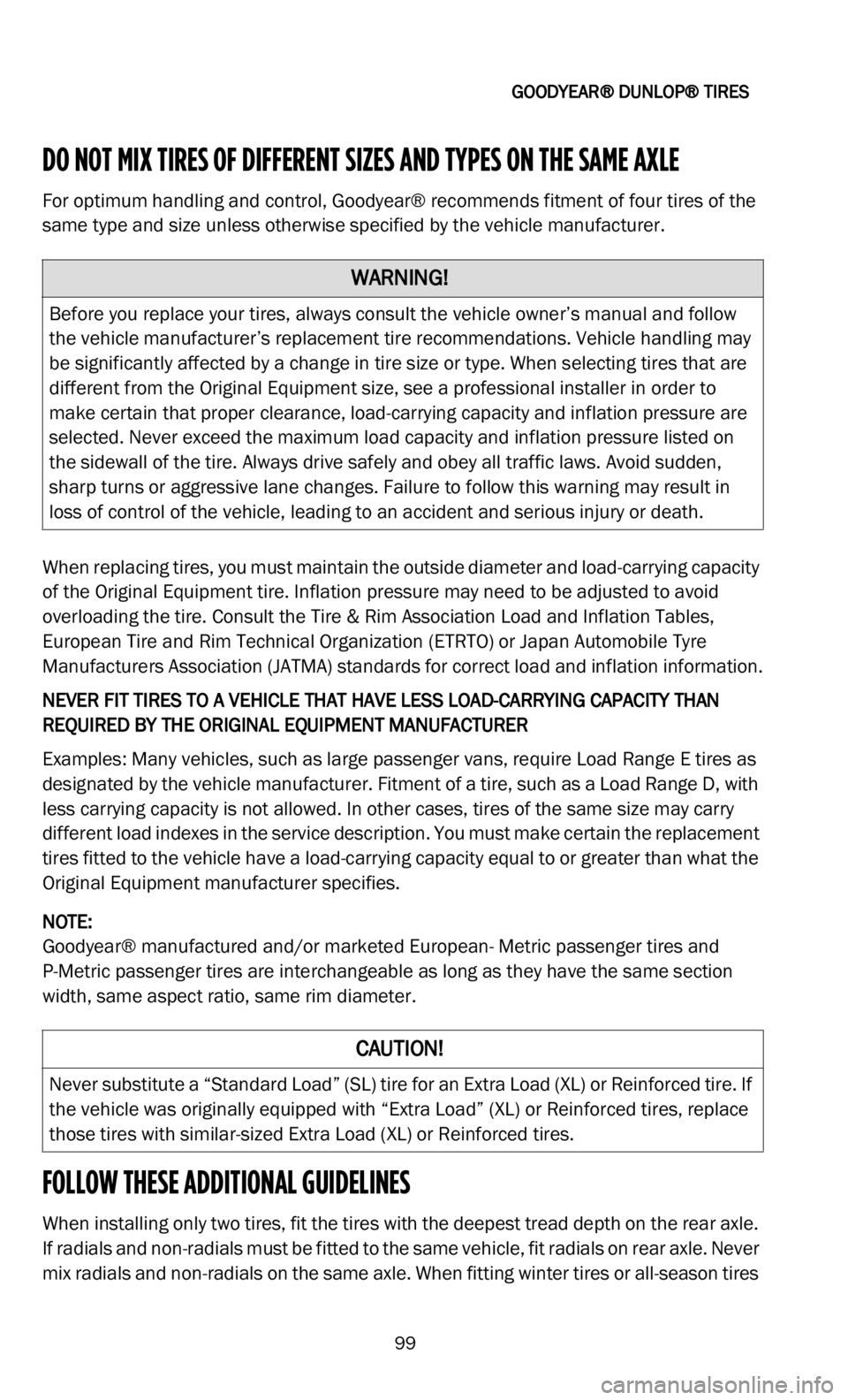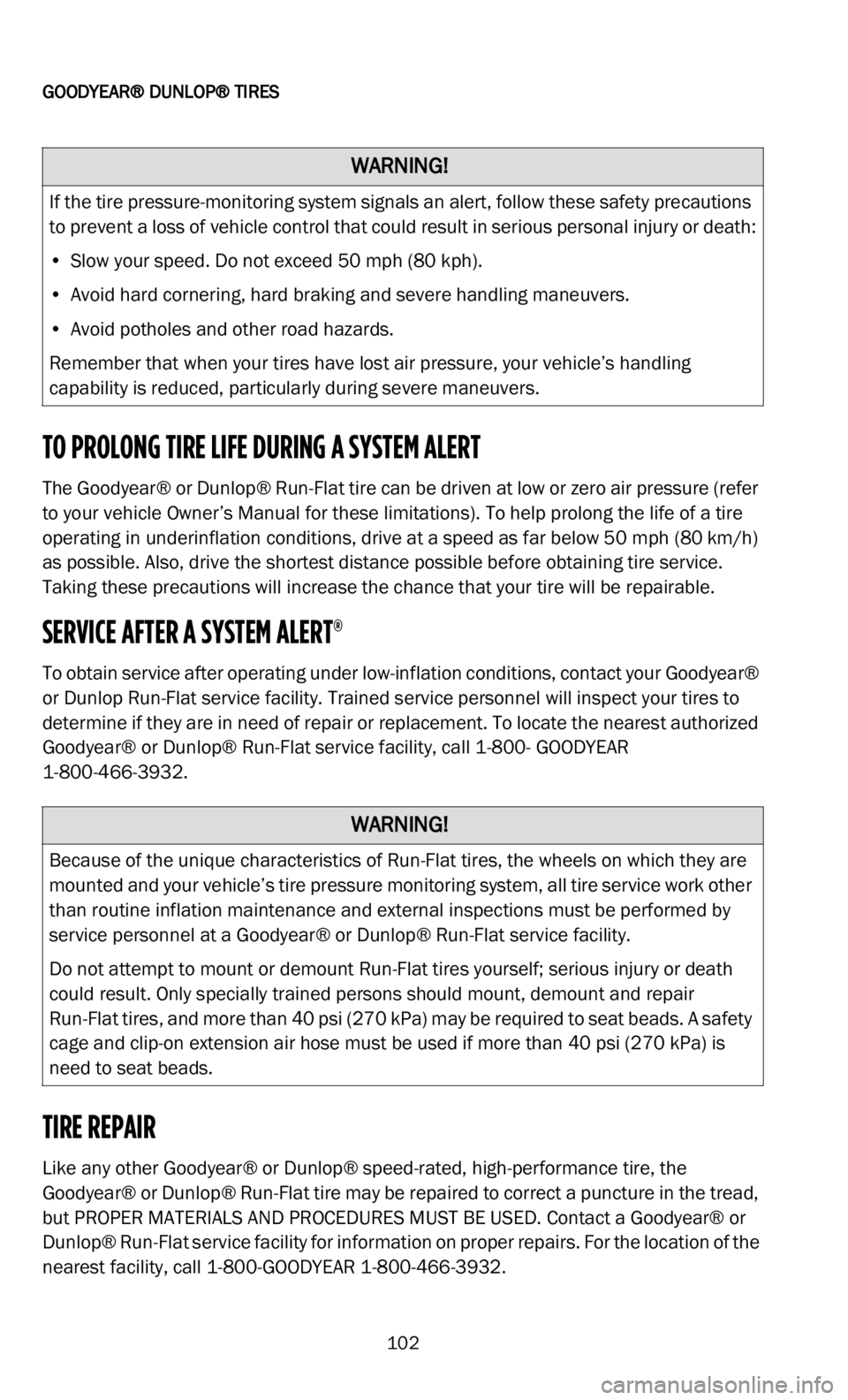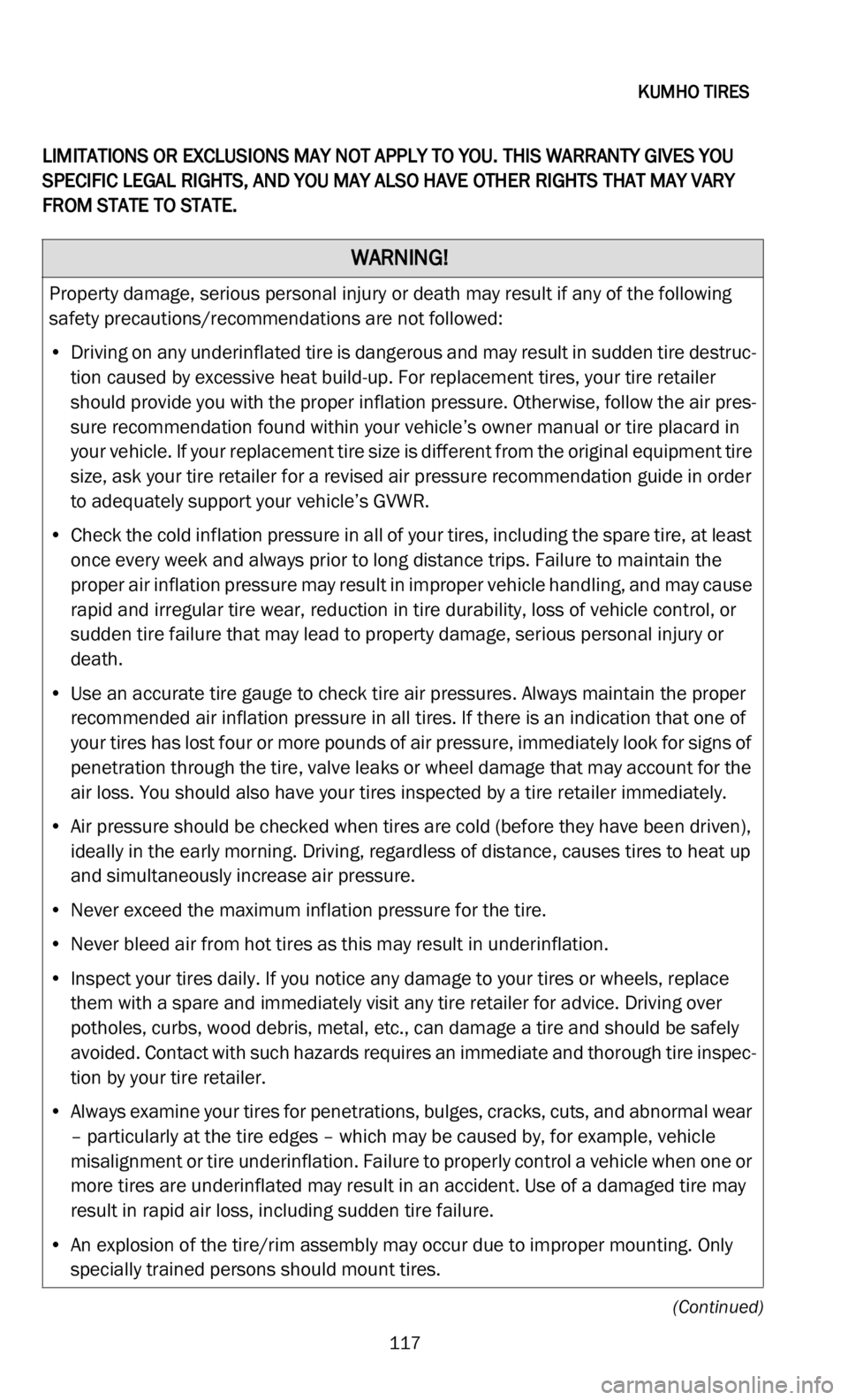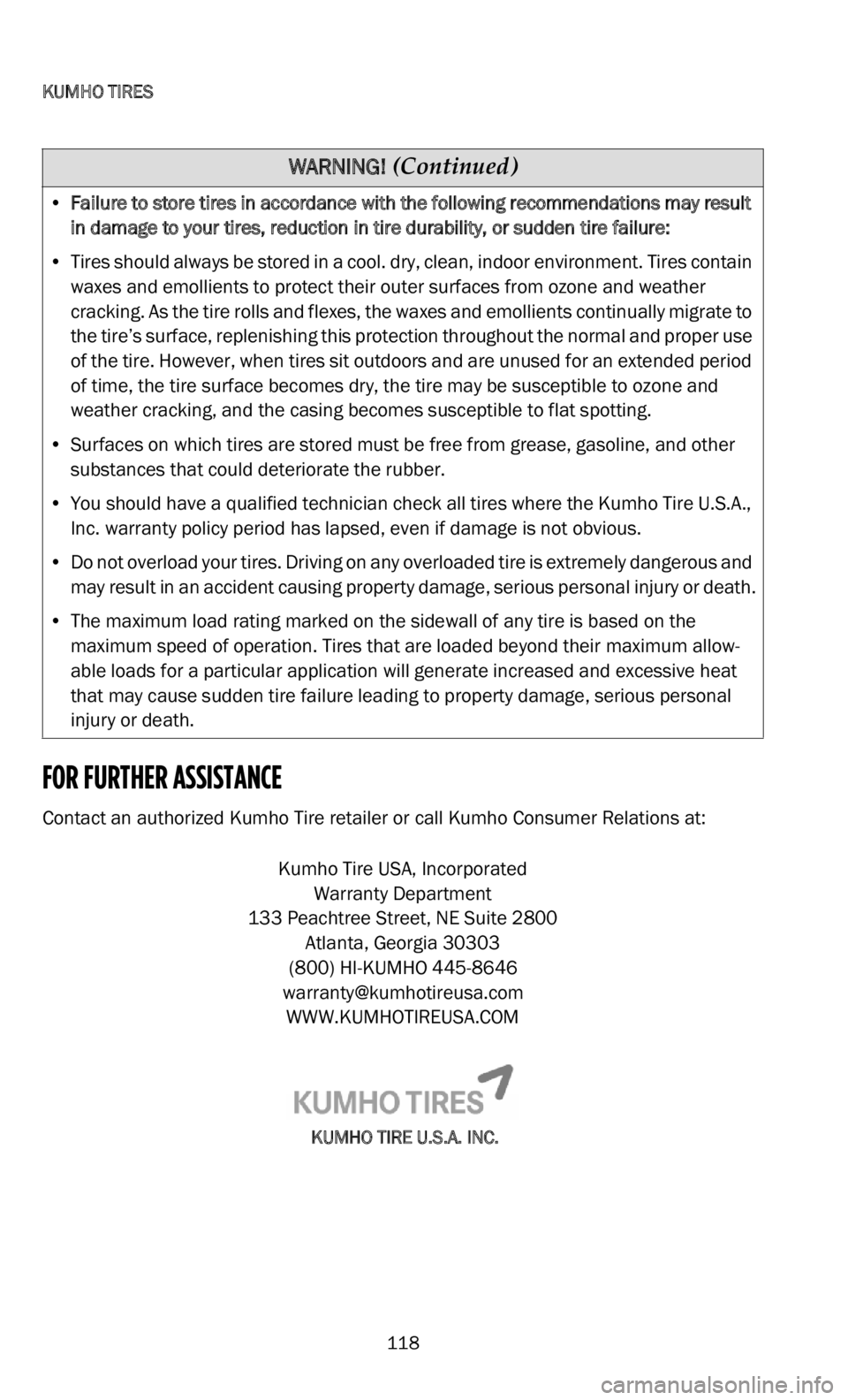warning DODGE DURANGO 2022 Vehicle Warranty
[x] Cancel search | Manufacturer: DODGE, Model Year: 2022, Model line: DURANGO, Model: DODGE DURANGO 2022Pages: 200, PDF Size: 6.72 MB
Page 100 of 200

GOODYEAR® DUNLOP® TIRES
99
DO NOT MIX TIRES OF DIFFERENT SIZES AND TYPES ON THE SAME AXLE
For optimum handling and control, Goodyear® recommends fitment of four tires of the
same type and size unless otherwise specified by the vehicle manufacturer.
When replacing tires, you must maintain the outside diameter and load-carrying capacity
of
the Original Equipment tire. Inflation pressure may need to be adjusted to avoid
overloading the tire. Consult the Tire & Rim Association Load and Inflation Tables,
European Tire and Rim Technical Organization (ETRTO) or Japan Automobile Tyre
Manufacturers Association (JATMA) standards for correct load and inflation information.
NEVER FIT TIRES TO A VEHICLE THAT HAVE LESS LOAD-CARRYING CAPACITY THAN
RE
QUIRED BY THE ORIGINAL EQUIPMENT MANUFACTURER
Examples: Many vehicles, such as large passenger vans, require Load Range E tires as
d e
signated by the vehicle manufacturer. Fitment of a tire, such as a Load Range D, with
less carrying capacity is not allowed. In other cases, tires of the same size may carry
different load indexes in the service description. You must make certain the replacement
tires fitted to the vehicle have a load-carrying capacity equal to or greater than what the
Original Equipment manufacturer specifies.
NOTE:
Goodyear® manufactured and/or marketed European- Metric passenger tires and
P -
Metric passenger tires are interchangeable as long as they have the same section
width, same aspect ratio, same rim diameter.
FOLLOW THESE ADDITIONAL GUIDELINES
When installing only two tires, fit the tires with the deepest tread depth on the rear axle.
If radials and non-radials must be fitted to the same vehicle, fit radials on rear axle. Never
mix radials and non-radials on the same axle. When fitting winter tires or all-season tires
WARNING!
Before you replace your tires, always consult the vehicle owner’s manual and follow
the vehicle manufacturer’s replacement tire recommendations. Vehicle handling may
be significantly affected by a change in tire size or type. When selecting tires that are
different from the Original Equipment size, see a professional installer in order to
make certain that proper clearance, load-carrying capacity and inflation pressure are
selected. Never exceed the maximum load capacity and inflation pressure listed on
the sidewall of the tire. Always drive safely and obey all traffic laws. Avoid sudden,
sharp turns or aggressive lane changes. Failure to follow this warning may result in
loss of control of the vehicle, leading to an accident and serious injury or death.
CAUTION!
Never substitute a “Standard Load” (SL) tire for an Extra Load (XL) or Reinforced tire. If
the vehicle was originally equipped with “Extra Load” (XL) or Reinforced tires, replace
those tires with similar-sized Extra Load (XL) or Reinforced tires.
Page 102 of 200

GOODYEAR® DUNLOP® TIRES
101
TIRE SERVICE LIFE
Tires are designed and built to provide many thousands of miles/kilometers of excellent
service. For maximum benefit, tires must be maintained properly to avoid tire damage
that may result in removal from service before the tread is worn down to minimum depth.
It is not practical to accurately predict the service life of any specific tire in chronological
t i
me since service conditions vary widely. The serviceability of a tire over time is a
function of the storage and service conditions (inflation pressure, load, speed, road
hazard injury, etc.) to which a tire is subjected. Consumers should not rely solely on the
appearance of the tire, but should be aware of any change in dynamic performance such
as increased air loss, noise or vibration, which could be a sign to remove the tire.
Therefore, it is essential to have tires, including spares, inspected regularly (at least
monthly) for proper inflation pressure, damage and treadwear.
Check your vehicle’s Owner’s Manual (or your vehicle) to determine if it is equipped with
r u
n-flat (extended mobility) tires. If your vehicle is equipped with run-flat tires, the
following applies:
RUN-FLAT TECHNOLOGY EXTENDED MOBILITY TECHNOLOGY (EMT™), RUNONFLAT®
( R
OF) AND DUNLOP® SELF-SUPPORTING TECHNOLOGY (DSST®) ORIGINAL EQUIPMENT
TIRES
IMPORTANT SAFETY INFORMATION
OPERATIONAL MONITORING
The information contained in this Limited Warranty Brochure applies only to the Original
E q
uipment tires supplied with your vehicle. In order for Goodyear® Run-Flat (Extended
Mobility Technology [EMT], RunOnFlat [ROF]) or Dunlop® Run-Flat (Dunlop® Self-
Supporting Technology [DSST]) tires to obtain the performance criteria stated within this
Limited Warranty, Goodyear® or Dunlop® Run-Flat tires must use specific parts, such as
a low tire pressure monitoring system authorized by the Original Equipment vehicle
manufacturer.
RUN-FLAT TIRE FEATURE:
The Goodyear® or Dunlop® Run-Flat tire is a high-performance tire with a remarkable
f e
ature: It can operate for limited distances with very low or even no inflation pressure
(refer to your Vehicle Owner’s Manual for these limitations). This is an important benefit,
especially if inflation loss occurs at a location where immediately stopping your vehicle
could be hazardous.
TIRE PRESSURE MONITORING SYSTEM ALERT:
Refer to your vehicle Owner’s Manual for more information on what to do if the tire
p r
essure warning system activates.
Page 103 of 200

GOODYEAR® DUNLOP® TIRES
102
TO PROLONG TIRE LIFE DURING A SYSTEM ALERT
The Goodyear® or Dunlop® Run-Flat tire can be driven at low or zero air pressure (refer
to your vehicle Owner’s Manual for these limitations). To help prolong the life of a tire
operating in underinflation conditions, drive at a speed as far below 50 mph (80 km/h)
a s
possible. Also, drive the shortest distance possible before obtaining tire service.
Taking these precautions will increase the chance that your tire will be repairable.
SERVICE AFTER A SYSTEM ALERT®
To obtain service after operating under low-inflation conditions, contact your Goodyear®
or Dunlop Run-Flat service facility. Trained service personnel will inspect your tires to
determine if they are in need of repair or replacement. To locate the nearest authorized
Goodyear® or Dunlop® Run-Flat service facility, call 1-800- GOODYEAR
1-800-466-3932.
TIRE REPAIR
Like any other Goodyear® or Dunlop® speed-rated, high-performance tire, the
Goodyear® or Dunlop® Run-Flat tire may be repaired to correct a puncture in the tread,
but PROPER MATERIALS AND PROCEDURES MUST BE USED. Contact a Goodyear® or
Dunlop® Run-Flat service facility for information on proper repairs. For the location of the
nearest facility, call 1-800-GOODYEAR 1-800-466-3932.
WARNING!
If the tire pressure-monitoring system signals an alert, follow these safety precautions
to prevent a loss of vehicle control that could result in serious personal injury or death:
• S low your speed. Do not exceed 50
mph (80 kph).
• A void hard cornering, hard braking and severe handling maneuvers.
•
Avoid potholes and other road hazards.
R
emember that when your tires have lost air pressure, your vehicle’s handling
c a
pability is reduced, particularly during severe maneuvers.
WARNING!
Because of the unique characteristics of Run-Flat tires, the wheels on which they are
mounted and your vehicle’s tire pressure monitoring system, all tire service work other
than routine inflation maintenance and external inspections must be performed by
service personnel at a Goodyear® or Dunlop® Run-Flat service facility.
Do not attempt to mount or demount Run-Flat tires yourself; serious injury or death
co
uld result. Only specially trained persons should mount, demount and repair
Run-Flat tires, and more than 40 psi (270 kPa) may be required to seat beads. A safety
cage and clip-on extension air hose must be used if more than 40 psi (270 kPa) is
need to seat beads.
Page 104 of 200

GOODYEAR® DUNLOP® TIRES
103
FOR SERVICE ASSISTANCE OR INFORMATION, FIRST CONTACT THE NEAREST
GOODYEAR® OR DUNLOP® RETAILER
1. For assistance in locating the nearest Goodyear® or Dunlop® Retailer, look in the Yellow Pages under Tire Dealers – New.
2. G o to w
ww.goodyear.com for US or www.goodyear.ca for Canada.
For Dunlop® tires, go to www.dunloptires.com for US & Canada. If additional assistance
is required, call the Customer Assistance Center at 1-800-321-2136 for US or
1 -
800-387-3288 for Canada.
Or write to:
Customer Assistance Center Dept 728
200 Innovation Way
Akron, OH 44316-0001
WARNING!
Goodyear® and Dunlop® Run-Flat tires are designed for use only on certain original
equipment wheels supplied with a properly operating low tire pressure-monitoring
system. If applied to a vehicle without a properly operating low tire pressure
monitoring system, the tires may fail when operated in an underinflated condition,
resulting in loss of vehicle control and possible serious injury or death. Application of
these tires to a vehicle not equipped with specified operational low tire
pressure-monitoring system constitutes improper and unsafe use of this product.
Page 107 of 200

HANKOOK TIRES
106
WARNING FOR YOUR SAFETY
•TIRE DEMOUNTING AND MOUNTING
Improper tire mounting and inflation procedures may cause tire beads to break
with explosive force during installation of the tire on the rim, causing personal
injury and property damage. Follow the US Tire Manufacturers Association
(USTMA) installation and safety procedure for mounting and inflating tires. Tire
and rim must match in size. Rim parts must match by manufacturer’s design.
Clean rim. Lubricate rim and beads. Do not exceed the maximum recommended
pressure to seat beads on rim. Use remote control inflation equipment and infla -
tion cage.
NOTE:
• N ever inflate over 40 psi to seat beads.
•
Mount radial ply tires only on rims designated by wheel manufacturer as suitable
f
or radial tire.
• O nly specially trained persons shall mount tires.
• AIR PRESSURE
Check the pressure in your tires, including your spare, at least monthly, and
always before and during extended driving. Check tires cold (at least three hours
after the vehicle has been stopped and before it is driven more than 1 mile or
1.6 kilometers). Do not reduce pressure when tires are hot, use an accurate air
p r
essure gauge to check pressure and maintain it at the level recommended on
the vehicle tire placard or in the Owner’s Manual. Underinflation produces
extreme flexing of sidewalls and builds up heat to the point that premature tire
failure may occur. Overinflation can cause the tires to be more susceptible to
impact damage. Cold tire pressures, however, should never be higher than the
limit molded on the sidewall.
• LOAD LIMITS
Never exceed the load-carrying limits molded onto the sidewall of your tires or the
maximum vehicle load limit as shown on the vehicle tire placard, whichever is
less. Overloading builds up excessive heat in the tire and leads to early and/or
sudden failure.
•HAZARDS
Avoid running over objects (e.g., chuckholes, rocks, curbs, metal, glass, etc.)
which may possibly cause internal tire damage. Continued use of a tire that has
suffered internal damage (which may not be externally visible) can lead to
dangerous tire failure. Determination of suspected internal damage requires
demounting the tire from its rim and examination by trained tire personnel.
•WORN TIRES
Never drive on worn tires. Tires should be replaced by trained personnel when
2/32 of an inch (1.6 mm) of tread depth remain, as indicated by treadwear indi -
cators molded into the tread grooves. Use of worn-out tires (less than 2/32 of an
i n
ch remaining tread depth) increases the probability of tire failure. In most
states, it is illegal to drive with less than 2/32 of an inch of remaining tread depth.
Page 118 of 200

KUMHO TIRES
117
(Continued)
LIMITATIONS OR EXCLUSIONS MAY NOT APPLY TO YOU. THIS WARRANTY GIVES YOU
SPECIFIC LEGAL RIGHTS, AND YOU MAY ALSO HAVE OTHER RIGHTS THAT MAY VARY
FROM STATE TO STATE.
WARNING!
Property damage, serious personal injury or death may result if any of the following
safety precautions/recommendations are not followed:
• D riving on any underinflated tire is dangerous and may result in sudden tire destruc -
t
ion caused by excessive heat build-up. For replacement tires, your tire retailer
s h
ould provide you with the proper inflation pressure. Otherwise, follow the air pres -
sure recommendation found within your vehicle’s owner manual or tire placard in
y o
ur vehicle. If your replacement tire size is different from the original equipment tire
size, ask your tire retailer for a revised air pressure recommendation guide in order
to adequately support your vehicle’s GVWR.
• C heck the cold inflation pressure in all of your tires, including the spare tire, at least
o
nce every week and always prior to long distance trips. Failure to maintain the
proper air inflation pressure may result in improper vehicle handling, and may cause
rapid and irregular tire wear, reduction in tire durability, loss of vehicle control, or
sudden tire failure that may lead to property damage, serious personal injury or
death.
• U se an accurate tire gauge to check tire air pressures. Always maintain the proper
r
ecommended air inflation pressure in all tires. If there is an indication that one of
your tires has lost four or more pounds of air pressure, immediately look for signs of
penetration through the tire, valve leaks or wheel damage that may account for the
air loss. You should also have your tires inspected by a tire retailer immediately.
• Air pressure should be checked when tires are cold (before they have been driven), i
deally in the early morning. Driving, regardless of distance, causes tires to heat up
and simultaneously increase air pressure.
• N ever exceed the maximum inflation pressure for the tire.
•
Never bleed air from hot tires as this may result in underinflation.
•
Inspect your tires daily. If you notice any damage to your tires or wheels, replace
t
hem with a spare and immediately visit any tire retailer for advice. Driving over
potholes, curbs, wood debris, metal, etc., can damage a tire and should be safely
avoided. Contact with such hazards requires an immediate and thorough tire inspec -
tion by your tire retailer.
• Always examine your tires for penetrations, bulges, cracks, cuts, and abnormal wear –
particularly at the tire edges – which may be caused by, for example, vehicle
misalignment or tire underinflation. Failure to properly control a vehicle when one or
more tires are underinflated may result in an accident. Use of a damaged tire may
result in rapid air loss, including sudden tire failure.
• An explosion of the tire/rim assembly may occur due to improper mounting. Only s
pecially trained persons should mount tires.
Page 119 of 200

KUMHO TIRES
118
FOR FURTHER ASSISTANCE
Contact an authorized Kumho Tire retailer or call Kumho Consumer Relations at:
KUMHO TIRE U.S.A. INC.
•Failure to store tires in accordance with the following recommendations may result
in damage to your tires, reduction in tire durability, or sudden tire failure:
• T ires should always be stored in a cool. dry, clean, indoor environment. Tires contain
w
axes and emollients to protect their outer surfaces from ozone and weather
cracking. As the tire rolls and flexes, the waxes and emollients continually migrate to
the tire’s surface, replenishing this protection throughout the normal and proper use
of the tire. However, when tires sit outdoors and are unused for an extended period
of time, the tire surface becomes dry, the tire may be susceptible to ozone and
weather cracking, and the casing becomes susceptible to flat spotting.
• S urfaces on which tires are stored must be free from grease, gasoline, and other
s
ubstances that could deteriorate the rubber.
• Y ou should have a qualified technician check all tires where the Kumho Tire U.S.A.,
I
nc. warranty policy period has lapsed, even if damage is not obvious.
• D o not overload your tires. Driving on any overloaded tire is extremely dangerous and
m
ay result in an accident causing property damage, serious personal injury or death.
• T he maximum load rating marked on the sidewall of any tire is based on the
m
aximum speed of operation. Tires that are loaded beyond their maximum allow -
able loads for a particular application will generate increased and excessive heat
t h
at may cause sudden tire failure leading to property damage, serious personal
injury or death.
Kumho Tire USA, IncorporatedWarranty Department
133 Peachtree Street, NE Suite 2800 Atlanta, Georgia 30303
(800) HI-KUMHO 4 4
5-8646
[email protected] WWW.KUMHOTIREUSA.COM
WARNING!
(Continued)
Page 120 of 200

119
MICHELIN®
Original Equipment Passenger & Light Truck Tire Owner’s Manual & Limited Warranty
MICHELIN® PASSENGER AND LIGHT TRUCK TIRE LIMITED WARRANTY
ABOUT THIS WARRANTY
As the original purchaser of a Michelin® passenger or light truck tire, you are covered by
all the benefits and conditions (subject to the maintenance recommendations and safety
warnings) contained in this booklet. To ensure your understanding of and compliance
with the terms and conditions of this warranty, please read it carefully. It is essential that
you also read and understand the safety and maintenance recommendations for tires
contained in this booklet.
Limited Mileage Warranty:
Michelin® passenger and light truck tires – replacement and original equipment – are
cov
ered by a limited mileage warranty (hereafter referred to as limited warranty for
treadwear). For the mileage warranty associated with each tire line, please see your
Michelin® tire retailer – or visit us at https://www.michelinman.com/home .
Certain conditions and limitations apply. Mileage warranties vary by tire line and certain
ex c
lusions may apply.
Self-Supporting Tires
Zero Pressure (ZP)
As the purchaser of a Michelin® Self-Supporting Zero Pressure (ZP) passenger tire,
mou
nted on a vehicle approved for ZP tires, equipped with a properly operating low tire
pressure warning system, you are covered by this warranty. Please pay close attention to
the Owner’s Manual part of this booklet since it provides specific safety and
maintenance information for your ZP tires.
Michelin® Self-Supporting Zero Pressure (ZP) tires are part of a very sophisticated system
whi
ch is designed to provide a very simple benefit: Peace of Mind. With these tires, you can
maneuver the vehicle up to 50 miles (80 kilometers) at 55 mph (90 km/h), unless
ot h
erwise specified in your vehicle owner’s manual, even though the tire has lost all air!
That means time to exit from the highway and get to a place where the tire can be
inspected, replaced, or possibly returned to service. The distance that can safely be
traveled following an air loss incident will depend upon the conditions under which the
vehicle is operating, the degree of air loss, the extent of the damage causing the air loss,
the ambient temperature, the load, and the operating speed of the vehicle. The fewer miles
you travel after an air loss incident, the greater the likelihood that the tire can be re-inflated
(or, if punctured, repaired) and returned to service.
Pax® System
The Michelin® PAX®® System is a very sophisticated system that includes the tire,
su p
port ring and gel, pressure sensing device, and wheel. In the event of a loss of tire air
pressure, with this system you can still carefully maneuver the vehicle at speeds up to
55 mph (90 km/h), for a distance of up to 125 miles (201 km), even though a tire has
Page 121 of 200

MICHELIN®
120
lost all air! That means time to get off the highway and get to a place where the tire can
be inspected, replaced, or possibly repaired and returned to service. That is peace of
mind!
MICHELIN® PASSENGER AND LIGHT TRUCK TIRE LIMITED WARRANTY
WHAT IS COVERED AND FOR HOW LONG
Passenger and Light Truck Tires Michelin® Passenger and Light Truck tires, used in
no
rmal service on the vehicle on which they were originally fitted and in accordance with
the maintenance recommendations and safety warnings contained in the attached
owner’s manual, are covered by this warranty against defects in workmanship and
materials for the life of the original usable tread, or six years from the date of purchase,
whichever occurs first. At that time, all warranties, express or implied, expire. The usable
tread is the original tread down to the level of the tread wear indicators - 2/32 of an inch
(1.6 mm) of tread remaining. Date of purchase is documented by new vehicle
re
gistration or tire sales invoice. If no proof of purchase is available, coverage will be
based on the date of manufacture.
Replacement will be made in accordance with the terms and conditions described under
“ H
ow Replacement Charges are Calculated”.
NOTE:
Your vehicle manufacturer may provide additional tire warranty coverage over and above
w h
at is provided by Michelin®. Consult your vehicle Owner’s Manual for further informa -
tion.
NOTE:
Some Michelin® Self-Supporting Zero Pressure (ZP) tires can only be mounted on special
S H
-M (Symmetric Hump - Modified) wheels. These tires bear the special SH-M designa -
tion, molded into the sidewall of the tire, next to the ZP designation. DO NOT MOUNT A
T I
RE WITH THE SH-M DESIGNATION ON THE SIDEWALL ON A STANDARD WHEEL. DOING
SO VOIDS THIS LIMITED WARRANTY AND COULD CAUSE THE TIRE TO BECOME UNSER -
VICEABLE AT LOW OR ZERO PRESSURE, RESULTING IN SERIOUS PERSONAL INJURY OR
D E
ATH.
Treadwear – Mileage Warranty Coverage for Michelin® Passenger and Light Truck Tires
Michelin® passenger and light truck tires are covered by a manufacturer’s limited
w a
rranty for treadwear. For the mileage warranty associated with a specific tire line,
please see your Michelin® tire retailer or visit us at https://www.michelinman.com/
home . Some vehicles come from the vehicle manufacturer with “split fitments” –
meaning different size tires on the front and rear axles. Because these tires cannot be
r o
tated as recommended by Michelin®, the mileage warranty on each rear tire will cover
half the number of miles as the standard mileage warranty for that particular tire design.
Michelin® Self-Supporting Zero Pressure (ZP) tires have the same mileage warranty as
the standard tire line of which they are a part, up to but not exceeding 30,000 miles.
D O
T-approved competition tires (e.g., Michelin® Pilot® Sport Cup tires) are excluded
from any mileage warranty. Michelin® Winter tires must be used during winter months
only, defined as a period beginning on or after September 1st of a given year and ending
Page 122 of 200

MICHELIN®
121
no later than April 30th of the following year. Michelin® winter tires require
documentation of the timing of the installation and removal of the tires each winter to
maintain coverage under the limited warranty for treadwear.
An important reminder:
No tire manufacturer can guarantee you a certain number of miles from a given tire.
D r
iving habits, driving conditions, road conditions, and vehicle maintenance all play a
part in the tread life of a tire. If a tire does not reach the warranted mileage, and the
owner of the tires has complied with the terms and conditions of the warranty, Michelin®
will replace the tires as described under “How Replacement Charges are calculated”.
Temporary Spares
Michelin® temporary spare tires are covered by this warranty for six years from the date
o f
purchase or until the first 2/32 of an inch (1.6 mm) of the original tread is worn off.
D a
te of purchase is documented by new vehicle registration or tire sales invoice. If no
proof of purchase is available, coverage will be based on date of manufacture. At that
time, all warranties, express or implied, expire.
WHAT IS NOT COVERED
Tires which become unserviceable due to:
• R oad hazard injury (e.g., a cut, snag, bruise, impact damage or puncture)
•
Incorrect mounting of the tire, tire/wheel imbalance or improper repair
•
Misapplication, improper maintenance, racing, underinflation, overinflation or other
a
buse
• U neven or rapid wear which is caused by mechanical irregularity in the vehicle such as
w
heel misalignment, (a measured tread difference of 2/32nds of an inch (1.6 mm) or
m o
re across the tread on the same tire)
• A ccident, fire, chemical corrosion, tire alteration, or vandalism
•
Use in commercial applications for tread wear; by this warranty for six years
•
Flat spotting caused by improper storage or brake lock
•
The addition of liquid, solid or gaseous materials other than air, nitrogen or carbon
d
ioxide (for example, waterbase sealers or balancing substances)
• C osmetic ozone or weather cracking
•
Use of Michelin® Self-Supporting Zero Pressure (ZP) tires without a properly operating
l
ow air pressure warning system
HOW REPLACEMENT CHARGES ARE CALCULATED
Passenger and Light Truck Tires
A tire which becomes unserviceable due to a condition covered by this workmanship and
ma
terials limited warranty will be replaced with a comparable new Michelin® tire, free of
charge, when 2/32nds of an inch (1.6 mm) or less of the original tread is worn, (or 25%
o r
less, whichever is more beneficial to the user) and within 12 months of the date of
p u
rchase. Mounting and balancing of the tire is included. You pay the cost of any other